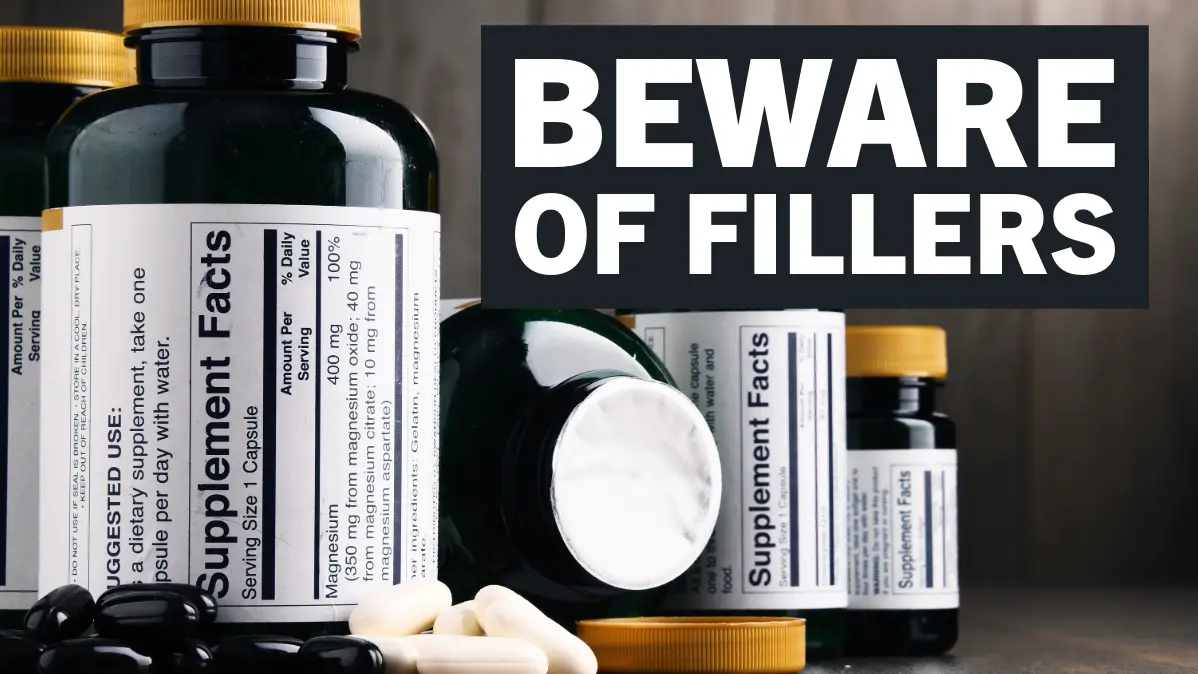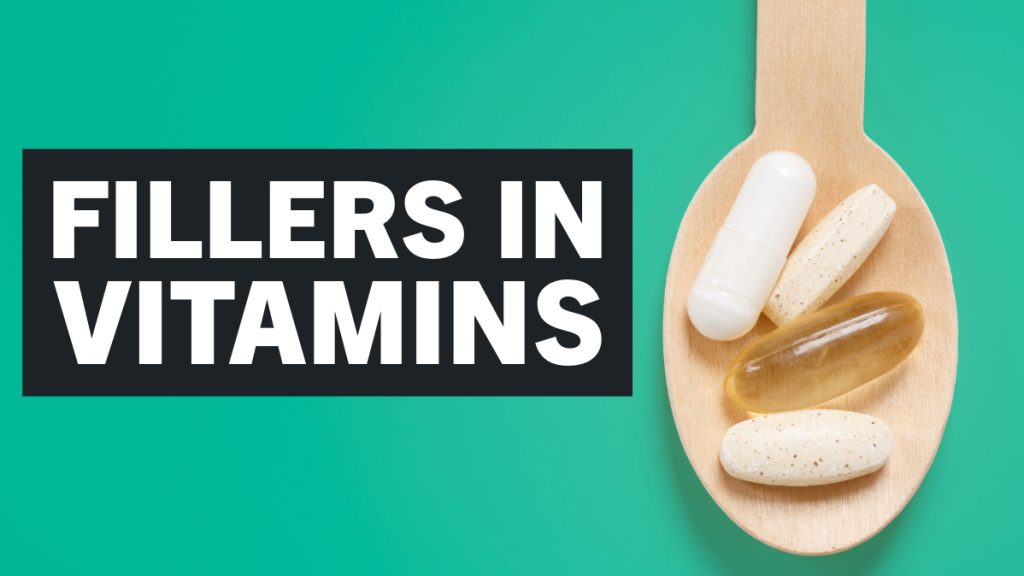What Are Fillers in Supplements? – Unveiling Inactive Ingredients

ListedFit is reader-supported. When you buy through links on our site, we may earn a small commission.
When we talk about supplements, we usually focus on the active ingredients that provide the benefits, like vitamins or minerals. However, there’s often less attention on the other components known as fillers.
Fillers in supplements serve various purposes, from bulking up the product to aid in manufacturing to ensuring stability and consistency.
They can be derived from a wide range of sources and are included in supplement formulations to improve appearance, prevent caking, or enhance absorption.

While the primary function of fillers is non-nutritive, their presence has raised questions among consumers seeking pure and high-quality supplements.
It’s important for me to know what exactly I’m consuming, therefore, understanding the role and safety of fillers is crucial.
The safety of fillers can vary, with the majority being harmless and some requiring careful consideration by people with allergies or sensitivities.
Moreover, transparency in labeling is key, allowing me to make informed decisions about the supplements that I choose. Labels that clearly list all ingredients, including fillers, indicate a higher level of transparency and help in identifying potential unwanted additives.
Key Points
- Fillers are common, non-nutritive substances in supplements that aid in manufacturing and promote product consistency.
- It’s crucial to understand the role and safety of fillers, as their impact varies based on type and individual sensitivities.
- Label clarity and ingredient transparency are essential for informed decisions about choosing high-quality supplements without unwanted additives.
Table of Contents
Understanding Fillers in Supplements
When I explore the realm of supplements, I find that fillers play a pivotal role in the formulation of capsules, tablets, powders, and liquids. They are often inert and added to supplements to achieve the desired consistency or volume.
Role and Purpose
Fillers, sometimes referred to as inactive ingredients, are substances that manufacturers add to supplements to facilitate production, aid in the physical structure of the supplement, and enhance the overall experience of the end-user.
In the context of capsules and tablets, fillers can help to create a uniformly shaped product and prevent ingredients from clumping together.
Fillers also allow for precise dosages, as the active ingredients often take up only a small part of the supplement.
For powders and liquids, fillers can improve the palatability and texture, making the supplement more pleasant to consume. Additionally, they can serve as carriers for the active ingredients, ensuring their distribution throughout the mixture.
What Fillers Are Used in Supplements? The Common Types of Fillers
Common fillers include materials like magnesium stearate, microcrystalline cellulose, and silicon dioxide.
Magnesium stearate often acts as a lubricant, while microcrystalline cellulose, derived from wood pulp, serves to bind and fill the tablet. Silicon dioxide, on the other hand, is a common anti-caking agent, preventing ingredients from sticking together and maintaining the free-flowing quality of powders.
- Magnesium Stearate: Lubricant in tablets and capsules.
- Microcrystalline Cellulose: Binder and filler in tablets.
- Silicon Dioxide: Anti-caking agent in powders.
What Fillers Are Used in Vitamins?

The fillers used in vitamins can be similar to those found in other supplements. However, in vitamins, my focus is often on the nutritional value or lack thereof that fillers might contribute. For example:
- Starches: As a filler, provide bulking properties without adding significant calories.
- Gelatin: Common in capsule making, it can provide a smooth dissolution of the capsule and can also be a source of amino acids.
- Lactose: Often used to help form tablets but can be an allergen to some individuals.
Vitamins may also contain fillers that accommodate special dietary needs, such as plant-based fillers for vegan products. In any case, the role of fillers in vitamins is to support the stability and usability of the product without detracting from its nutritional value.
Are Fillers Safe?

In this section, we’ll examine the safety of fillers in supplements, considering their potential health impacts, what regulatory standards exist, and address common concerns about whether fillers in vitamins and supplements are detrimental to our health.
Potential Health Impact
My research into fillers used in dietary supplements shows that these substances are generally considered safe when they meet quality and purity standards.
The active ingredients are the primary focus, but the fillers—which may include binders, coatings, or colorants—play a crucial role in the stability and delivery of the supplement.
When fillers are selected and utilized properly in the manufacturing process, they should not introduce toxicity into the product. However, some fillers have been controversial due to potential allergic reactions or digestive issues in sensitive individuals.
Regulatory Standards
The Food and Drug Administration (FDA) oversees the safety of dietary supplements, but it does not approve them as it does with drugs. Instead, manufacturers are expected to ensure safety and compliance with FDA guidelines.
Third-party organizations like the U.S. Pharmacopeia (USP) provide voluntary certification programs where supplements are tested for their quality, potency, and purity.
When fillers are part of a supplement that is USP certified, I can have greater confidence in their use as they adhere to stringent regulatory standards.
Are fillers in vitamins and supplements bad for you?
In essence, fillers in vitamins and supplements aren’t inherently bad for you, but their safety depends on the quality of the filler and the manufacturing process.
For most people, standard fillers that are non-toxic and used in regulated amounts pose little risk.
The controversy usually arises from fillers that either cause reactions in some people or are perceived to dilute the effectiveness of the active ingredients.
It’s essential to look for products that have been tested for safety and efficacy. Always check if a product has been associated with toxicity issues or other safety concerns, which could be indicators that a filler might not be suitable for everyone.
How to Spot Fillers – Labeling and Transparency
When examining supplement labels, I focus on the listed ingredients and certifications that hint at the presence of fillers. It’s crucial to decode the information presented to make informed choices.
Interpreting Supplement Labels
Supplement labels can be a treasure trove of information if you know how to read them. I always look for key certifications such as vegetarian, vegan, non-GMO, or organic.
These certifications mean the product has met certain standards and typically indicates a cleaner product.
Transparency is key, so labels that list all ingredients, including fillers, allow me to know exactly what I’m consuming.
Recognizable ingredients are generally a good sign; if an ingredient sounds like a chemistry experiment, it may be a filler.
For instance, if I see “microcrystalline cellulose” or “silicon dioxide,” I understand that these are common fillers used to aid in the manufacturing process or to prevent caking.
Identifying allergens is also important since some fillers might trigger allergies.
Spotting Red Flags
There are certain red flags on labels that signal unnecessary fillers.
Words like “proprietary blend” can sometimes be code for a mix of high-quality ingredients and fillers – since they don’t have to disclose the ratio.
As for artificial colors or flavors, I tend to stay away from them because they often add no nutritional value and are potential fillers.
I also look at the serving size and dosage. If a supplement recommends a large serving size but the active ingredients seem minimal, this could indicate the presence of fillers.
A transparent product label should leave me feeling informed, not confused. If I find myself scratching my head over the ingredient list, it’s usually a sign to reconsider my choice.
Choosing the Right Supplement
When I choose dietary supplements, it’s crucial for me to consider my personal dietary needs and the efficacy of the products in question. I focus on finding the right vitamins and minerals to complement my diet while ensuring they genuinely contribute to my health.
Personal Dietary Needs
As someone with unique dietary requirements, I carefully assess the nutritional value of each supplement. Since dietary needs vary—for example, vegetarians and vegans may require additional B12—ensuring the vitamins or minerals are suitable for my diet is a priority.
I check the label for serving size and recommended doses to match my needs. Here’s a quick checklist to consider:
- Nutrient Profile: Does it cover my specific nutrient gaps?
- Diet Compatibility: Is it appropriate for my dietary choices, such as plant-based?
- Serving Size: Is the serving size practical for me to take daily?
Evaluating Supplement Efficacy
Before adding any supplements to my regimen, I determine their efficacy.
A potent supplement should ideally be free from unnecessary fillers and additives, which impact the overall efficacy.
I look for credible information on their bioavailability and how well the nutrient is expected to work in my body. Here’s what I typically look for:
- Bioavailability: The higher, the better, as this means more absorption.
- Clinical Research: Are there studies backing the claimed benefits?
- Fillers and Additives: I opt for products with minimal artificial colors, sweeteners, or fillers, as discussed on ndhealthfacts.org.
By following this approach, I ensure that any supplement I select has a legitimate chance of supporting my overall health.
Frequently Asked Questions

In navigating the world of dietary supplements, it’s crucial to understand the role and impact of ingredients that don’t contribute to nutritional value—commonly known as fillers or additives. These can have varying effects on our health and it’s important for me to be aware of them.
Which additives should I look out for in vitamin supplements?
In my vitamin supplements, I typically watch out for additives like artificial colors, titanium dioxide, and certain preservatives, which may be associated with health concerns.
Can the bulking agents in vitamins lead to any adverse effects on health?
Yes, bulking agents such as microcrystalline cellulose and maltodextrin can cause adverse effects in some individuals, including digestive discomfort.
How can I identify if my supplements contain unnecessary fillers or binders?
I look at the ingredients label to spot fillers or binders—terms like ‘stearic acid’ or ‘silicon dioxide’ might indicate their presence.
Are there health risks associated with consuming fillers in vitamin tablets?
It’s possible; certain fillers might cause allergic reactions or gastrointestinal issues in sensitive individuals.
What natural alternatives are used to avoid synthetic fillers in vitamins?
Natural alternatives like rice bran and powdered fruit are used to substitute synthetic fillers in vitamins.
Could the use of bulking agents in tablet supplements contribute to weight gain?
While bulking agents in supplements typically contain minimal calories, excessive consumption could theoretically contribute to weight gain. However, this is uncommon.
Author
- Danny Loeb is a qualified Personal Trainer, Fitness Model and Writer. He enjoys blogging about health and fitness, messing around with Photoshop, and sharing his experiences with everyone.
Latest entries
 NutritionFebruary 6, 2024What Are Fillers in Supplements? – Unveiling Inactive Ingredients
NutritionFebruary 6, 2024What Are Fillers in Supplements? – Unveiling Inactive Ingredients FitnessAugust 23, 2023Best Post-Workout Foods: Great Ideas for Recovery and Results
FitnessAugust 23, 2023Best Post-Workout Foods: Great Ideas for Recovery and Results BulkingJuly 26, 2023Is Rice Good for Bulking? Unveiling the Truth
BulkingJuly 26, 2023Is Rice Good for Bulking? Unveiling the Truth CultureJuly 15, 2023Why Do People Hate Planet Fitness? Read This Before You Join!
CultureJuly 15, 2023Why Do People Hate Planet Fitness? Read This Before You Join!
Affiliates:
This post may contain affiliate links that at no additional cost to you, the site may earn a small commission. We only recommend products we would use ourselves and all opinions expressed on this site are our own.
General Advice:
The information provided in this article is for general informational purposes only. It is not intended as a substitute for professional advice. Always consult with a qualified healthcare professional before starting any new diet, exercise program, or making changes to your health routine.
Accuracy Advice:
While we strive to provide up-to-date and accurate information, the content in this article may not reflect the most current research or medical guidelines. We encourage readers to do further research and consult with professionals for more personalized advice.
Our Recommendations:
The products and services mentioned in any of our articles are recommended based on our independent research and personal experience. We are not sponsored by any company. We aim to suggest products and services we believe are of high quality and could be beneficial to our readers.






